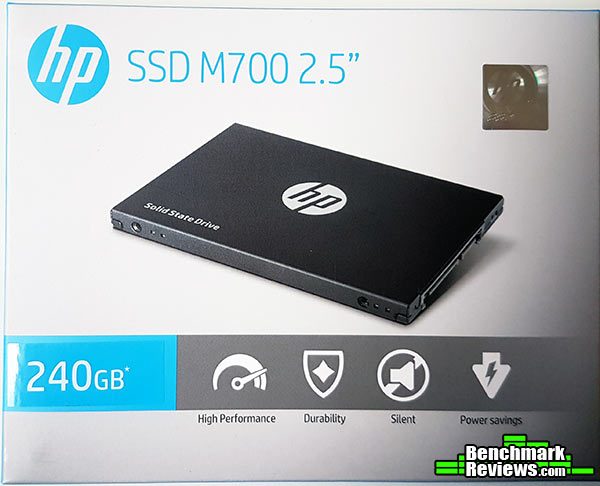PAGE INDEX
HP SSD M700 Solid State Drive Review
By Olin Coles
Manufacturer: HP, Inc. (Hewlett-Packard Development Company, L.P.)
Product Name: SSD M700 2.5″ 240GB
Part Number: 3DV74AA#ABC
UPC: 192018567450 EAN: 6955914605367
Price As Tested: 240GB – $99.99 MSRPFull Disclosure: The product sample used in this article has been provided by HP.
Hewlett-Packard, the ubiquitous brand name that was once the staple of nearly every printer and most personal computers in the country, later refocused its efforts into peripheral electronics and devices after the desktop PC market contracted. Storage devices, such as external drives and component hardware upgrades, have been a very competitive market segment for the past few years, paving the way for successful technology alliances that allow brands like HP to offer some of the best solutions available.
If you’ve kept up with technology news, you might have been misled into believing the SATA 6Gb/s interface was made obsolete by M.2 2280 form factor connections on the Peripheral Component Interconnect Express (PCIe) 3.0 interface. The HP SSD M700 is a 2.5″ solid state drive for the SATA 6Gb/s interface, which is still widely found on mainstream desktop computers and notebook PCs.
The HP SSD M700 is an entry-level solid state drive, with up to 560 MB/s read and 520 MB/s write speeds from the 240GB SSD M700 model, which utilizes 2D Planar NAND technology to deliver solid reliability. Adding to its appeal is the cost of solid state drive technology, which has doubled its storage capacity per dollar from just one year ago. In this article for Benchmark Reviews, we test the HP SSD M700 (model 3DV74AA#ABC) against the competition.
HP SSD M700 Specifications
- M700 features a dual core HP controller with four flash memory channels supporting NANDXtend ECC
- Reliability (MTBF) 2M hours, and Endurance (TBW) up to 145 TBW
- Higher Order LDPC Error Correction for high speed parallel decoding and real time error correction to ensure data integrity and security
- All Metal Body – heat dissipation and durability in a PC environment
- Full compatibility with HPdst.exe (HP Software Pre-installation Environment). Ideal upgrade for HP PCs
- Manufactured to HP’s high quality standards and fully tested and certified in HP Laboratories
- 1-800 Technical Support Provided
| Capacity | 120GB, 240GB |
| Form Factor | 2.5″ |
| NAND Flash | 2D Planar MLC |
| Features | TRIM and ECC Supported S.M.A.R.T Supported NCQ Management HP DST Self Test |
| Dimensions (L x W x H) | 100.0 x 69.5 x 6.9 mm |
| Weight | 1.60 oz |
| Interface | SATA 6 Gb/s |
| Sequential R/W Performance | Up to 560 MBps read / Up to 520 MBps write (240GB) *Actual performance may vary due to available SSD capacity, system hardware, software components, and other factors. |
| Operating temperature | 0°C-70°C |
| Storage temperature | -40°C – 85°C |
| Shock resistance | 100 G / 0.6 ms |
| Total Bytes Written | 240 GB = 145 TB Written |
| MTBF | 2,000,000 hours |
| Power Consumption (Idle) | 0.6 W |
| Power Consumption (Active) | 1.7W (Typical) |
Bandwidth Speed vs Operational Performance
Solid State Drive performance revolves around two dynamics: bandwidth speed (MB/s) and operational performance I/O per second (IOPS). These two metrics work together, but one may be more important than the other depending on the workload. Consider this analogy: bandwidth determines how much cargo a ship can transport in one voyage, and operational IOPS performance is how fast that ship moves back and forth. By understanding this and applying it to SSD storage, there is a clear importance set on each variable depending on the task at hand.
For casual users, especially those with laptop or desktop computers that have been upgraded to use an SSD, the naturally quick response time is enough to automatically improve the user experience. Bandwidth speed is important, but only to the extent that operational performance meets the minimum needs of the system. If an SSD has a very high bandwidth speed but a low operational performance, it will take longer to load applications and boot the computer’s Operating System than another SSD that offers higher IOPS performance.





Most Recent Comments